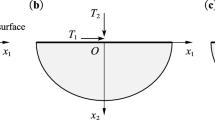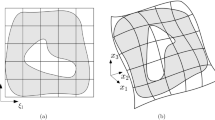Abstract
Highly efficient and versatile computational electromagnetic analysis of 3-D transformation-based metamaterial cloaking structures based on a hybridization of a higher order finite element method for discretization of the cloaking region and a higher order method of moments for numerical termination of the computational domain is proposed and demonstrated. The technique allows for an effective modeling of the continuously inhomogeneous anisotropic cloaking region, for cloaks based on both linear and nonlinear coordinate transformations, using a very small number of large curved finite elements with continuous spatial variations of permittivity and permeability tensors and high-order p-refined field approximations throughout their volumes, with a very small total number of unknowns. In analysis, there is no need for a discretization of the permittivity and permeability profiles of the cloak, namely for piecewise homogeneous (layered) approximate models, with material tensors replaced by appropriate piecewise constant approximations. Numerical results show a very significant reduction (three to five orders of magnitude for the simplest possible 6-element model and five to seven orders of magnitude for an h-refined 24-element model) in the scattering cross section of a perfectly conducting sphere with a metamaterial cloak, in a broad range of wavelengths. Given the introduced explicit approximations in modeling of the spherical geometry and continuous material tensor profiles (both by fourth-order Lagrange interpolating functions), and inherent numerical approximations involved in the finite element and moment method techniques and codes, the cloaking effects are shown to be predicted rather accurately by the full-wave numerical analysis method.








Similar content being viewed by others
References
Alù A, Engheta N (2011) Optical metamaterials based on optical nanocircuits. Proc IEEE 99(10):1669–1681. doi:10.1109/JPROC.2011.2160834
Engheta N, Ziolkowski RW (eds) (2006) Metamaterials: physics and engineering explorations, 1st edn. Wiley-IEEE Press, New York
Christophe C, Tatsuo I (2005) Electromagnetic metamaterials: transmission line theory and microwave applications, 1st edn. Wiley-IEEE Press, New York
Capolino F (2009) Metamaterials handbook, 1st edn. CRC Press, New York
Cai W, Shalaev VM (2010) Optical metamaterials: fundamentals and applications, 1st edn. Springer, New York
Pendry JB (2004) Negative refraction. Contemp Phys 45(3):191–202. doi:10.1080/00107510410001667434
Scherer A, Painter O, Vuckovic J, Loncar M, Yoshie T (2002) Photonic crystals for confining, guiding, and emitting light. IEEE Trans Nanotechnol 1(1):4–11. doi:10.1109/TNANO.2002.1005421
Pendry JB, Schurig D, Smith DR (2006) Controlling electromagnetic fields. Science 312(5781):1780–1782. doi:10.1126/science.1125907
Schurig D, Pendry JB, Smith DR (2006) Calculation of material properties and ray tracing in transformation media. Opt Express 14(21):9794–9804. doi:10.1364/OE.14.009794
Cummer SA, Popa B-I, Schurig D, Smith DR, Pendry J (2006) Full-wave simulations of electromagnetic cloaking structures. Phys Rev E 74(3):036621. doi:10.1103/PhysRevE.74.036621
Zolla F, Guenneau S, Nicolet A, Pendry JB (2007) Electromagnetic analysis of cylindrical invisibility cloaks and the mirage effect. Opt Lett 32(9):1069–1071. doi:10.1364/OL.32.001069
Ni Y, Gao L, Qiu C-W (2010) Achieving invisibility of homogeneous cylindrically anisotropic cylinders. Plasmonics 5(3):251–258. doi:10.1007/s11468-010-9145-8
Farhat M, Guenneau S, Movchan AB, Enoch S (2008) Achieving invisibility over a finite range of frequencies. Opt Express 16(8):5656–5661. doi:10.1364/OE.16.005656
Huang Y, Feng Y, Jiang T (2007) Electromagnetic cloaking by layered structure of homogeneous isotropic materials. Opt Express 15(18):11133–11141. doi:10.1364/oe.15.011133
Schurig D, Mock JJ, Justice BJ, Cummer SA, Pendry JB, Starr AF, Smith DR (2006) Metamaterial electromagnetic cloak at microwave frequencies. Science 314(5801):977–980. doi:10.1126/science.1133628
Yan M, Yan W, Qiu M (2009) Invisibility cloaking by coordinate transformation. In: Emil W (ed) Progress in optics, vol 52., pp 261–304. doi:10.1016/s0079-6638(08)00006-1
Kwon D-H, Werner DH (2010) Transformation electromagnetics: an overview of the theory and applications. IEEE Antenn Propag Mag 52(1):24–46. doi:10.1109/MAP.2010.5466396
Maci S (2010) A cloaking metamaterial based on an inhomogeneous linear field transformation. IEEE Trans Antenn Propag 58(4):1136–1143. doi:10.1109/TAP.2010.2041272
Xie Y, Chen H, Xu Y, Zhu L, Ma H, Dong J-W (2011) An invisibility cloak using silver nanowires. Plasmonics 6(3):477–481. doi:10.1007/s11468-011-9226-3
Chen H, Wu B-I, Zhang B, Kong JA (2007) Electromagnetic wave interactions with a metamaterial cloak. Phys Rev Lett 99(6):063903. doi:10.1103/PhysRevLett.99.063903
Qiu C, Hu L, Zhang B, Wu B-I, Johnson SG, Joannopoulos JD (2009) Spherical cloaking using nonlinear transformations for improved segmentation into concentric isotropic coatings. Opt Express 17(16):13467–13478. doi:10.1364/OE.17.013467
Furlani EP, Baev A (2009) Optical nanotrapping using cloaking metamaterial. Phys Rev E 79(2):026607. doi:10.1103/PhysRevE.79.026607
Alù A, Engheta N (2007) Plasmonic materials in transparency and cloaking problems: mechanism, robustness, and physical insights. Opt Express 15(6):3318–3332. doi:10.1364/OE.15.003318
Ilić MM, Notaroš BM (2003) Higher order hierarchical curved hexahedral vector finite elements for electromagnetic modeling. IEEE Trans Microw Theor Tech 51(3):1026–1033. doi:10.1109/TMTT.2003.808680
Djordjević M, Notaroš BM (2004) Double higher order method of moments for surface integral equation modeling of metallic and dielectric antennas and scatterers. IEEE Trans Antenn Propag 52(8):2118–2129. doi:10.1109/TAP.2004.833175
Ilić MM, Djordjević M, Ilić AŽ, Notaroš BM (2009) Higher order hybrid FEM-MoM technique for analysis of antennas and scatterers. IEEE Trans Antenn Propag 57(5):1452–1460. doi:10.1109/TAP.2009.2016725
Ilić MM, Ilić AŽ, Notaroš BM (2009) Continuously inhomogeneous higher order finite elements for 3-D electromagnetic analysis. IEEE Trans Antenn Propag 57(9):2798–2803. doi:10.1109/TAP.2009.2027350
Guild MD, Haberman MR, Alù A (2011) Plasmonic cloaking and scattering cancelation for electromagnetic and acoustic waves. Wave Motion 48(6):468–482. doi:10.1016/j.wavemoti.2011.02.006
Notaroš BM (2008) Higher order frequency-domain computational electromagnetics. IEEE Trans Antenn Propag 56(8):2251–2276. doi:10.1109/TAP.2008.926784
Acknowledgments
This work was supported by the National Science Foundation under grants ECCS-0650719 and ECCS-1002385 and by the Serbian Ministry of Science and Technological Development under grant TR-32005.
Author information
Authors and Affiliations
Corresponding author
Rights and permissions
About this article
Cite this article
Savić, S.V., Manić, A.B., Ilić, M.M. et al. Efficient Higher Order Full-Wave Numerical Analysis of 3-D Cloaking Structures. Plasmonics 8, 455–463 (2013). https://doi.org/10.1007/s11468-012-9410-0
Received:
Accepted:
Published:
Issue Date:
DOI: https://doi.org/10.1007/s11468-012-9410-0




